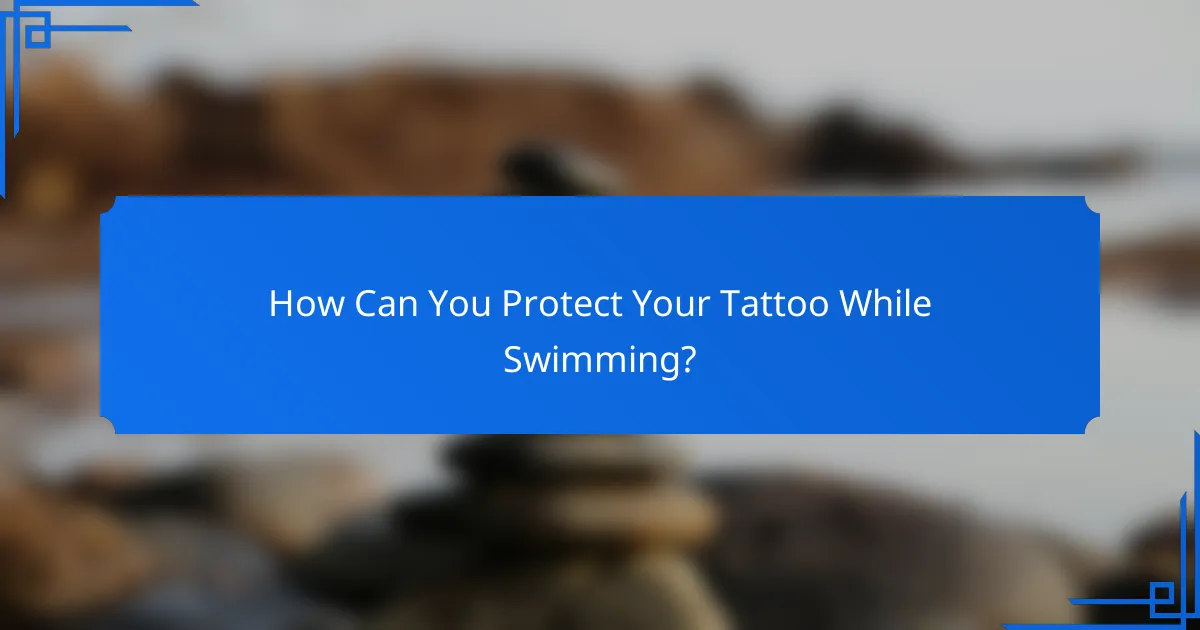Swimming can pose challenges for maintaining the vibrancy of your tattoo, especially if it’s new. To ensure your ink stays intact, it’s essential to wait at least two to three weeks post-tattoo before diving in. Utilizing waterproof covers, specialized tattoo sunscreen, and moisturizing creams can significantly help protect your tattoo from fading and irritation while enjoying the water.

How Can You Protect Your Tattoo While Swimming?
To protect your tattoo while swimming, consider using waterproof covers, applying sunscreen, and limiting your time in the water. These strategies help prevent fading and irritation, ensuring your tattoo remains vibrant and healthy.
Use waterproof tattoo cover
A waterproof tattoo cover is a specialized adhesive film designed to shield your tattoo from water exposure. These covers create a barrier that prevents chlorine or saltwater from penetrating the skin, which can cause fading or irritation.
When selecting a cover, look for products specifically labeled as waterproof and breathable. Ensure it adheres well to your skin and is large enough to fully cover your tattoo.
Apply sunscreen on the tattoo
Applying sunscreen on your tattoo is crucial for protecting it from harmful UV rays that can cause fading. Use a broad-spectrum sunscreen with a high SPF, ideally 30 or higher, to ensure maximum protection.
Reapply sunscreen every two hours, especially after swimming or towel drying. This helps maintain the integrity of your tattoo while keeping your skin safe from sun damage.
Limit exposure time
Limiting your time in the water is an effective way to protect your tattoo. Aim to keep your swimming sessions to under an hour, especially in chlorinated or salty water, which can be harsher on your skin.
If you’re swimming in a pool or the ocean, consider taking breaks to allow your skin to dry and reduce prolonged exposure to potentially damaging elements.
Choose fresh water over salt water
Freshwater pools are generally less harsh on tattoos compared to saltwater environments. Saltwater can dry out the skin and lead to irritation, which may affect the appearance of your tattoo.
If possible, opt for swimming in freshwater lakes or pools, especially during the healing process of your tattoo. This choice can help maintain its vibrancy and reduce the risk of fading.
Shower before and after swimming
Showering before swimming helps cleanse your skin, removing oils and dirt that can interfere with the tattoo cover’s adhesion. It also hydrates your skin, providing an additional layer of protection.
After swimming, rinse your tattoo with fresh water to remove chlorine or salt residue. Pat it dry gently with a clean towel, and reapply sunscreen if you plan to stay outdoors.

What Are the Best Products for Tattoo Protection?
To effectively protect your tattoo while swimming, consider using waterproof bandages, specialized tattoo sunscreen, and moisturizing creams. Each product serves a unique purpose in preserving the integrity and appearance of your tattoo during water exposure.
Waterproof bandages
Waterproof bandages are designed to create a barrier over your tattoo, preventing water from seeping in. They are particularly useful for fresh tattoos, as they help shield the area from chlorine and saltwater, which can cause irritation and fading.
When selecting a waterproof bandage, look for options that are breathable yet secure. Ensure that the adhesive is strong enough to withstand water but gentle on the skin to avoid irritation when removed.
Specialized tattoo sunscreen
Specialized tattoo sunscreen provides essential protection against UV rays, which can fade tattoo colors over time. These sunscreens are formulated to be safe for tattooed skin and often contain ingredients that hydrate while shielding against sun exposure.
Choose a broad-spectrum sunscreen with a high SPF, ideally 30 or above. Apply it generously on your tattoo before swimming and reapply every two hours, especially after swimming or towel drying.
Moisturizing creams
Moisturizing creams help maintain the vibrancy of your tattoo by keeping the skin hydrated. Well-hydrated skin is less likely to crack or peel, which can lead to fading or distortion of the tattoo design.
Opt for fragrance-free and hypoallergenic moisturizing creams to avoid irritation. Apply the cream daily, especially after swimming, to replenish moisture and protect the tattoo from drying out due to chlorine or saltwater exposure.

How Long Should You Wait to Swim After Getting a Tattoo?
It’s generally recommended to wait at least two to three weeks before swimming after getting a tattoo. This waiting period allows your tattoo to heal properly and reduces the risk of infection or fading caused by exposure to water.
Wait at least 2-3 weeks
Waiting at least two to three weeks is crucial for the healing process of your tattoo. During this time, the skin forms a protective barrier over the tattoo, which helps prevent bacteria from entering and causing infections. Swimming in pools, lakes, or oceans too soon can expose your tattoo to harmful chemicals or irritants.
Consider that the healing time may vary based on the size and location of the tattoo, as well as your individual skin type. Larger tattoos or those in areas prone to friction may require more time to heal fully.
Consult your tattoo artist for advice
Your tattoo artist is a valuable resource for personalized advice on when to swim after your tattoo session. They can provide insights based on their experience and knowledge of your specific tattoo. Artists often have their own recommendations based on the techniques they used and the ink they applied.
Don’t hesitate to ask your artist about aftercare tips and any signs of complications to watch for during the healing process. Following their guidance will help ensure your tattoo looks its best for years to come.

What Are Common Risks of Swimming with a New Tattoo?
Swimming with a new tattoo poses several risks, primarily infection, fading of the ink, and allergic reactions to swimming products. Understanding these risks can help you take the necessary precautions to protect your tattoo while enjoying the water.
Infection from bacteria
New tattoos are essentially open wounds, making them vulnerable to bacterial infections when exposed to water. Swimming pools, lakes, and oceans can harbor harmful bacteria that may enter the skin and cause complications.
To minimize this risk, avoid swimming for at least two to three weeks after getting your tattoo. If swimming is unavoidable, consider using a waterproof bandage to cover the tattoo, but ensure it is applied correctly to prevent water from seeping in.
Fading of tattoo ink
Exposure to chlorine in swimming pools and saltwater can lead to fading of tattoo ink over time. The chemicals in these waters can break down the pigments used in tattoos, diminishing their vibrancy.
To protect your tattoo from fading, limit your time in the water and rinse your tattoo with fresh water immediately after swimming. Applying a high-SPF sunscreen can also help shield the tattoo from UV rays, which can further contribute to fading.
Allergic reactions to products
Swimming pools often contain chemicals like chlorine, which can trigger allergic reactions in some individuals, especially those with sensitive skin or newly tattooed skin. These reactions can cause redness, itching, and discomfort around the tattoo area.
Before swimming, check the pool’s chemical levels if possible, and consider using a barrier cream on your tattoo to provide extra protection. If you experience any adverse reactions, consult a dermatologist for appropriate treatment options.

What Should You Consider When Choosing a Swimming Location?
When selecting a swimming location, consider factors such as water cleanliness, type of water, and temperature. These elements can significantly impact the health of your tattoo and its healing process.
Cleanliness of the water
The cleanliness of the water is crucial for protecting your tattoo. Swimming in clean, well-maintained pools reduces the risk of infection, while murky or polluted waters can harbor bacteria that may harm your skin.
Before swimming, check for any visible signs of contamination, such as debris or unusual odors. If you’re at a public pool, ensure it meets health regulations, which often include regular testing and treatment of the water.
Type of water (chlorinated vs. natural)
The type of water you swim in can affect your tattoo’s longevity. Chlorinated water, commonly found in pools, can cause fading and irritation, especially in fresh tattoos. Natural bodies of water, like lakes or oceans, may contain bacteria and pollutants that could lead to infections.
If you choose to swim in chlorinated water, consider waiting at least two weeks after getting your tattoo to minimize damage. For natural water, ensure your tattoo is fully healed before diving in.
Temperature of the water
Water temperature can influence your tattoo’s healing and comfort. Warm water can open pores, potentially allowing ink to leach out, while cold water may cause discomfort or tightening of the skin.
Ideally, swim in water that is comfortably warm but not excessively hot. If the water feels too warm, it may be best to avoid swimming until your tattoo has fully healed to prevent any adverse effects.


